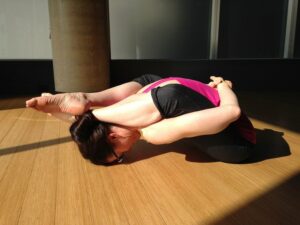Stretching’s status in the fitness industry is impressive. We stretch with an almost religious fervor. We stretch to warm up, to cool down, and in every small rest in between sets.
I see runners stretching their quads before their weekly 5k. I see therapists prescribing stretching every day. Every gym instructor and personal trainer is taught to do 5-10 minutes of static training at the end of every session, as well as a few at the beginning.
So, stretching must be really important right?
Well, no.
In actual fact, stretching is a waste of time for most people just looking to get stronger and play a bit of sport.
STATIC STRETCHING VS DYNAMIC STRETCHING
Let me first clarify exactly the kind of stretching I am talking about here. Not all stretching is equal, and some types of stretching are more useful than other.
Stretching can be classified into two broad categories, static and dynamic:

-
Static stretching: slowly taking a muscle to a point of mild discomfort or tension and then holding for anywhere between eight seconds and five minutes. Example: standing hamstring/calf stretch, the kind you were made to do in PE.
-
Dynamic stretching: taking a joint through its full available range of movement with a controlled, rhythmic movement. Example:
-
hip swings or rolling your shoulders
The mode of stretching I have a problem with is the most commonplace type of stretching: static stretching.
Dynamic stretching has its place during a warm-up to help lubricate your joints before exercise and get you prepped for the session. I’ll leave dynamic stretching alone for now and when I say stretching from now on I mean static stretching. (Note: any old warm-up designed to get your heart rate up will probably do just as good a job, if not better)
WHY SO MUCH STRETCHING
It’s almost a dogma of the fitness industry that stretching and flexibility, are good for you. Stretching is supposed to improve sports performance, reduce your risk of injury and reduce the effects of delayed-onset muscle soreness (you know, the inability to walk downstairs after having done a load of squats for the first time in ages).
DOES IT LIVE UP TO THE HYPE?
The fact of the matter is, stretching doesn’t do any of that:
-
Stretching before exercise has not been shown to improve sports performance. On the contrary, studies have actually found that stretching before training may actually harm your performance. Here’s a quote from one study that looked at the long-term effect of stretching in athletes: “Overall, the evidence suggests that increasing range of motion beyond function through stretching is not beneficial and can actually cause injury and decrease performance.” (Caveat: this is an area of controversy and ongoing research, as of 2021 it looks like it probably doesn’t harm performance.)
-
The idea that stretching can reduce your risk of injury has been shown, repeatedly, to be false. If you want to reduce your risk of injury, you’re much better off starting a strength training program than with stretching.
-
The same goes for reducing the effect of delayed-onset muscle soreness. It just doesn’t work. Nothing does.

IS THERE ANY BENEFIT TO STRETCHING?
Stretching IS definitely good for one thing: getting more flexible.
But that’s the point, I hear you cry! If stretching is good at getting us more flexible then we should do it.
Yes, but no.
Yes, if you need to get more flexible for a particular activity or skill you are trying to learn then stretching will get you there. Realistically it will have to be a part of a serious flexibility improvement programme with stretches held for 30-60 seconds up to five minutes and incorporating a range of other flexibility strategies (some of which you can find here).
But the studies linked to above all point to the fact that once you have the level of flexibility required to do your sport/training/daily activities, there’s really no need to go any further.
Every bit of additional flexibility you gain requires more muscular strength and stability in order to control your joint in that extra range. So, by making yourself more flexible than you need to be, you may well be making yourself less efficient at moving, and more prone to injury (that’s speculative, but a reasonable presumption).
So if your daily life doesn’t require extreme levels of flexibility, and it’s not something you desire, you may not need more than you have. And even if you do, full-range strength training and eccentric training can also build flexibility while at the same time building significant levels of strength.
Why waste your time on static stretching?

SOME GOOD THINGS TO SAY ABOUT STRETCHING
Having completely lambasted stretching, I want to say a couple of good things about it.
First of all, it can feel pretty good! It feels like we’re doing something good when we stretch. And particularly after a heavy training session when our muscles are feeling heavy and soar, it feels relaxing.
Done right, by twinning stretching with deep breathing (somewhat akin to yoga), stretching can be meditative and quite therapeutic.
Secondly, if you need to be more flexible then you’ll probably have to stretch.
But if you’re just stretching endlessly, day in and day out, then you’re missing out on a whole host of techniques that can get you more flexible, more quickly while simultaneously building strength & control.
If you’re serious about wanting to get flexible strong then click below and see if we might be a good fit working together.
Wherever you are in the world I can help you get flexible strong and unlock mobility you never thought possible.